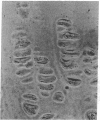Abstract
To study the effect of locally infused growth hormone (GH) or insulin-like growth factor I(IGF-I) on slowly cycling cells in the germinal cell layer of the tibial growth plate, osmotic minipumps delivering 14.3 microCi of [3H]thymidine per day were implanted s.c. into hypophysectomized rats, and GH (1 microgram) or IGF-I (10 micrograms) was injected daily through a cannula implanted in the proximal tibia. The opposite leg served as a control. After 12 days of treatment, the osmotic minipumps were removed, and three rats in each group were given GH (20 micrograms/day, s.c.) for an additional 14 days to chase the labeled cells out of the proliferative layers. Labeled cells remained in the germinal layer, in the perichondrial ring, and on the surface of the articular cartilage close to the epiphyseal plate. GH administered together with labeled thymidine significantly increased the number of labeled cells in the germinal cell layer compared to that in the control leg (ratio = 1.95 +/- 0.13), whereas IGF-I showed no stimulatory effect (ratio = 0.96 +/- 0.04). Therefore GH but not IGF-I stimulates the multiplication of the slowly cycling (label-retaining) cells in the germinal layer of the epiphyseal plate. IGF-I acts only on the proliferation of the resulting chondrocytes.
Full text
PDF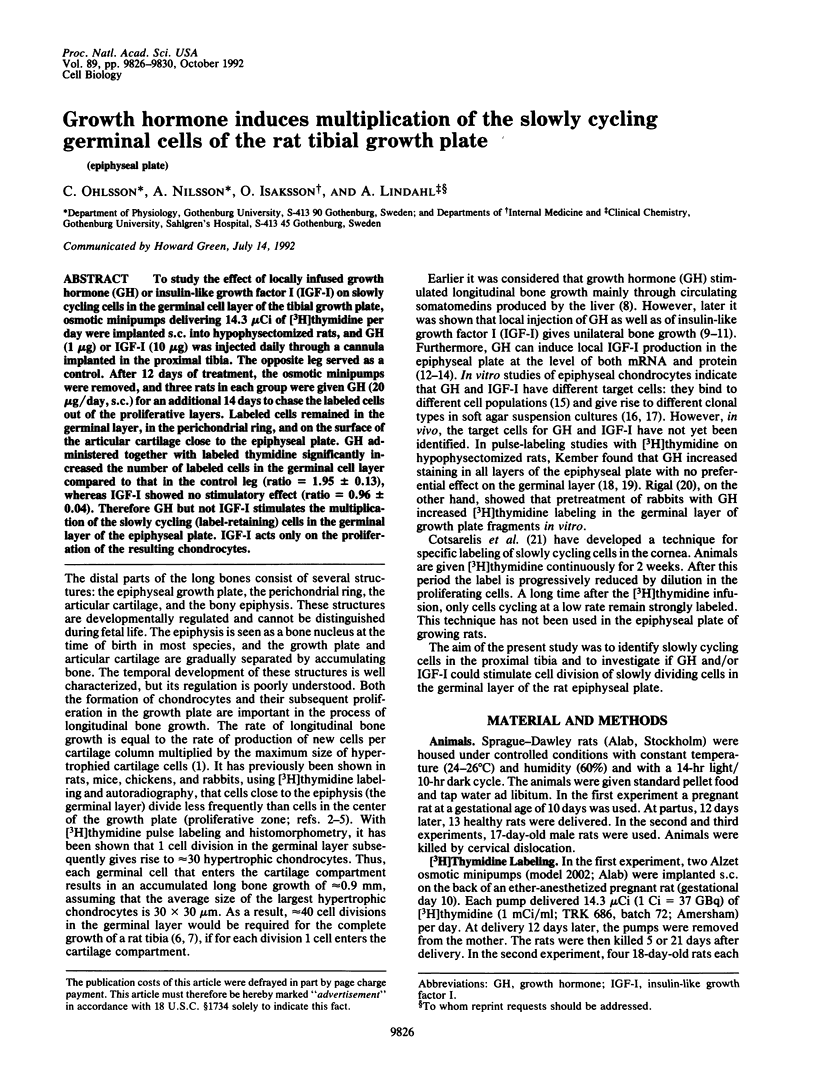
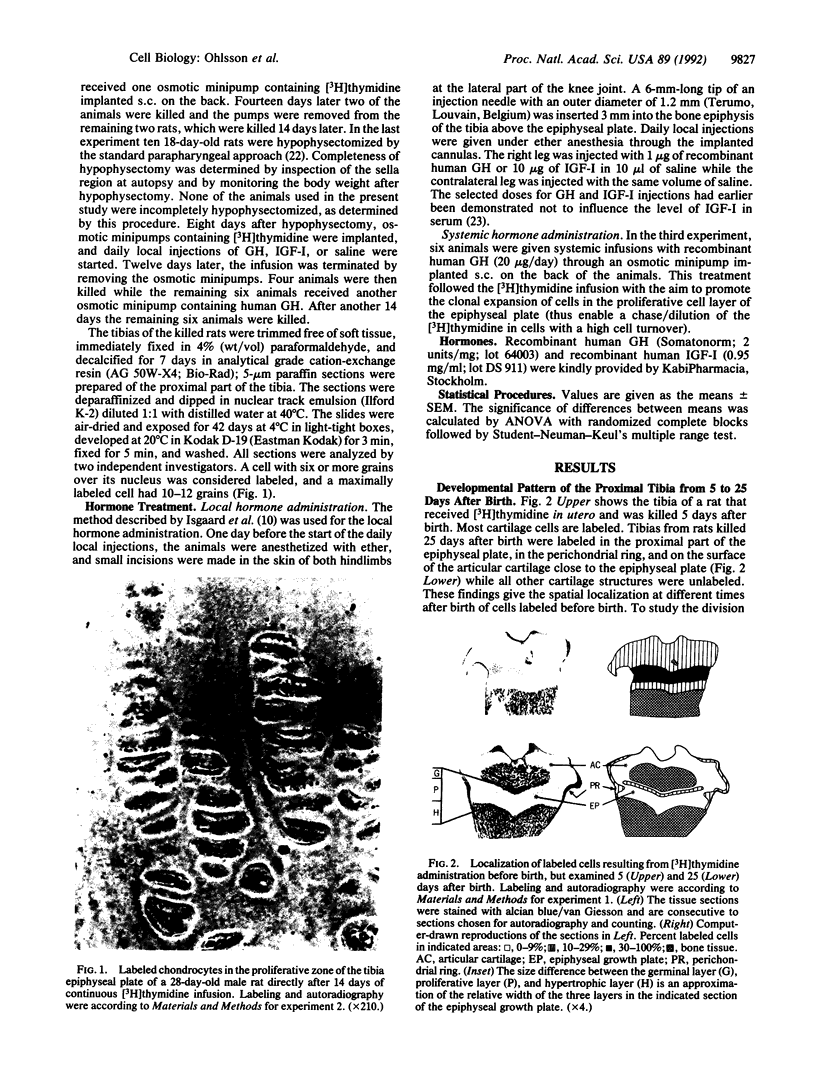
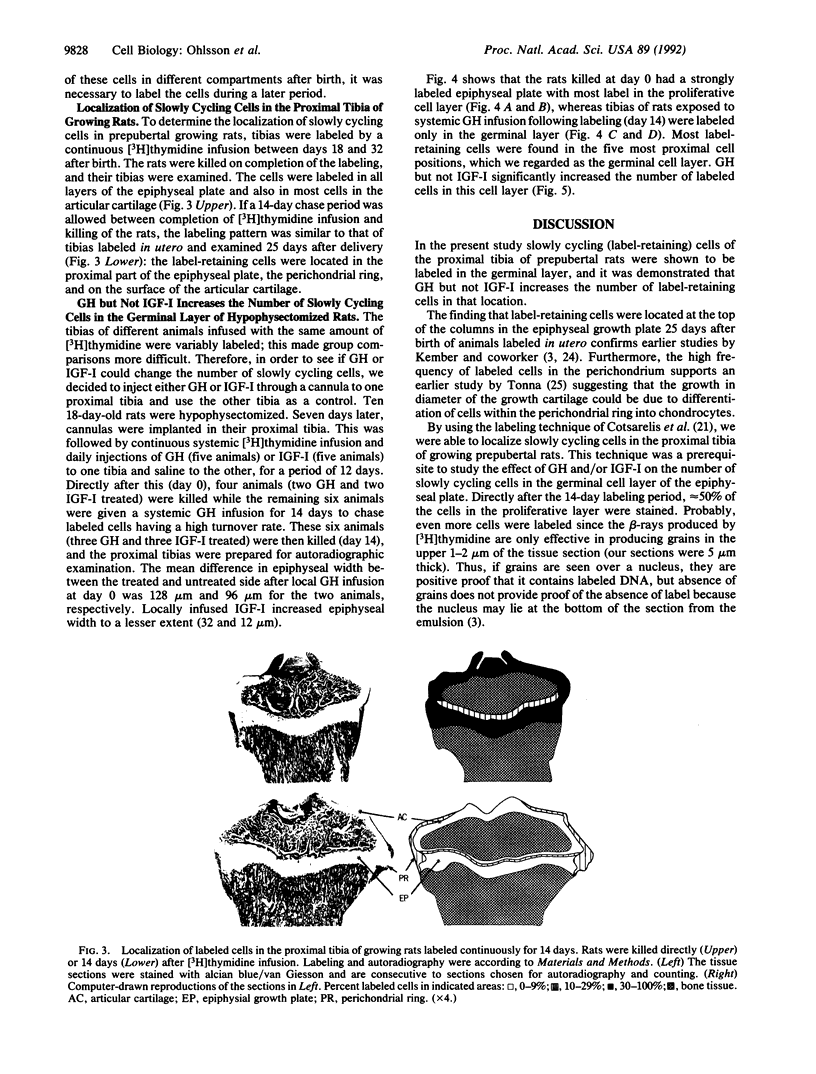
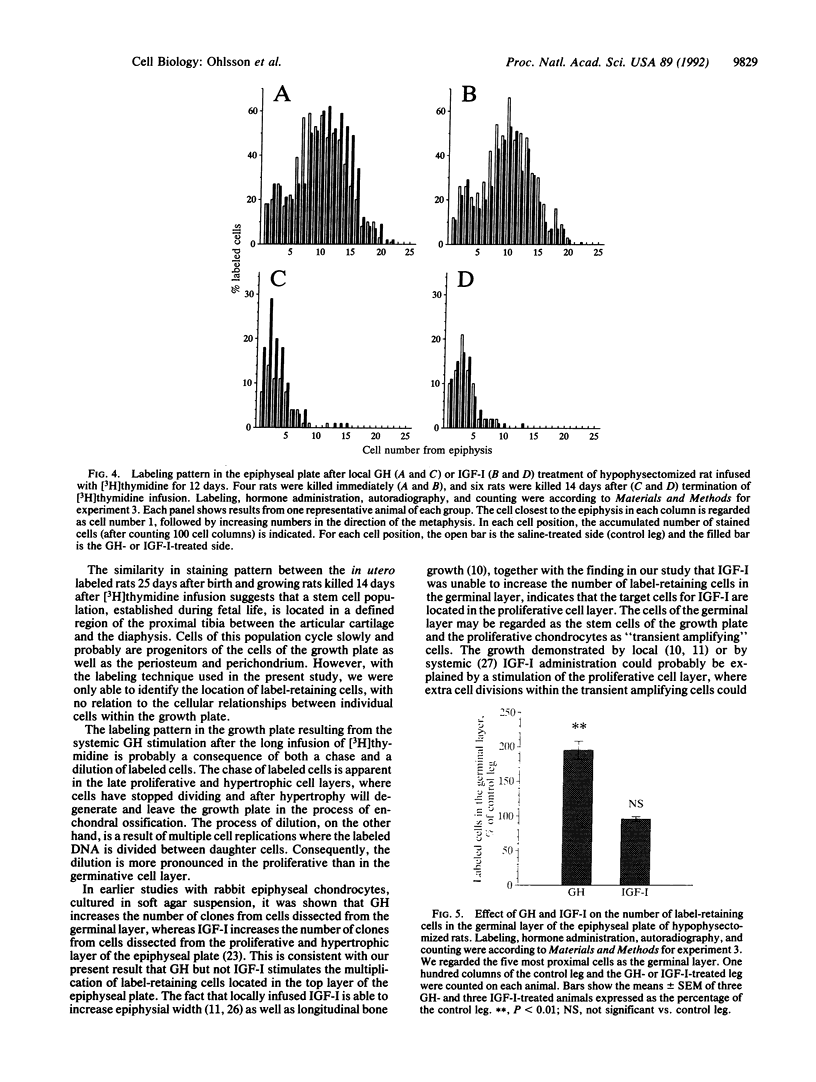

Images in this article
Selected References
These references are in PubMed. This may not be the complete list of references from this article.
- BELANGER L. F., MIGICOVSKY B. B. Bone cell formation and survival in H3-thymidine-labeled chicks under various conditions. Anat Rec. 1963 Mar;145:385–390. doi: 10.1002/ar.1091450303. [DOI] [PubMed] [Google Scholar]
- Cotsarelis G., Cheng S. Z., Dong G., Sun T. T., Lavker R. M. Existence of slow-cycling limbal epithelial basal cells that can be preferentially stimulated to proliferate: implications on epithelial stem cells. Cell. 1989 Apr 21;57(2):201–209. doi: 10.1016/0092-8674(89)90958-6. [DOI] [PubMed] [Google Scholar]
- Green H., Morikawa M., Nixon T. A dual effector theory of growth-hormone action. Differentiation. 1985;29(3):195–198. doi: 10.1111/j.1432-0436.1985.tb00316.x. [DOI] [PubMed] [Google Scholar]
- Guler H. P., Zapf J., Scheiwiller E., Froesch E. R. Recombinant human insulin-like growth factor I stimulates growth and has distinct effects on organ size in hypophysectomized rats. Proc Natl Acad Sci U S A. 1988 Jul;85(13):4889–4893. doi: 10.1073/pnas.85.13.4889. [DOI] [PMC free article] [PubMed] [Google Scholar]
- Isaksson O. G., Jansson J. O., Gause I. A. Growth hormone stimulates longitudinal bone growth directly. Science. 1982 Jun 11;216(4551):1237–1239. doi: 10.1126/science.7079756. [DOI] [PubMed] [Google Scholar]
- Isaksson O. G., Lindahl A., Nilsson A., Isgaard J. Mechanism of the stimulatory effect of growth hormone on longitudinal bone growth. Endocr Rev. 1987 Nov;8(4):426–438. doi: 10.1210/edrv-8-4-426. [DOI] [PubMed] [Google Scholar]
- Isgaard J., Möller C., Isaksson O. G., Nilsson A., Mathews L. S., Norstedt G. Regulation of insulin-like growth factor messenger ribonucleic acid in rat growth plate by growth hormone. Endocrinology. 1988 Apr;122(4):1515–1520. doi: 10.1210/endo-122-4-1515. [DOI] [PubMed] [Google Scholar]
- Isgaard J., Nilsson A., Lindahl A., Jansson J. O., Isaksson O. G. Effects of local administration of GH and IGF-1 on longitudinal bone growth in rats. Am J Physiol. 1986 Apr;250(4 Pt 1):E367–E372. doi: 10.1152/ajpendo.1986.250.4.E367. [DOI] [PubMed] [Google Scholar]
- KEMBER N. F. Cell division in endochondral ossification. A study of cell proliferation in rat bones by the method of tritiated thymidine autoradiography. J Bone Joint Surg Br. 1960 Nov;42B:824–839. [PubMed] [Google Scholar]
- Kember N. F. Cell kinetics and the control of growth in long bones. Cell Tissue Kinet. 1978 Sep;11(5):477–485. doi: 10.1111/j.1365-2184.1978.tb00820.x. [DOI] [PubMed] [Google Scholar]
- Kember N. F. Cell population kinetics of bone growth: the first ten years of autoradiographic studies with tritiated thymidine. Clin Orthop Relat Res. 1971 May;76:213–230. doi: 10.1097/00003086-197105000-00029. [DOI] [PubMed] [Google Scholar]
- Kember N. F. Growth hormone and cartilage cell division in hypophysectomized rats. Cell Tissue Kinet. 1971 Mar;4(2):193–199. doi: 10.1111/j.1365-2184.1971.tb01529.x. [DOI] [PubMed] [Google Scholar]
- Kember N. F., Lambert B. E. Slowly cycling cells in growing bone. Cell Tissue Kinet. 1981 May;14(3):327–330. doi: 10.1111/j.1365-2184.1981.tb00536.x. [DOI] [PubMed] [Google Scholar]
- Lindahl A., Isgaard J., Carlsson L., Isaksson O. G. Differential effects of growth hormone and insulin-like growth factor I on colony formation of epiphyseal chondrocytes in suspension culture in rats of different ages. Endocrinology. 1987 Sep;121(3):1061–1069. doi: 10.1210/endo-121-3-1061. [DOI] [PubMed] [Google Scholar]
- Lindahl A., Nilsson A., Isaksson O. G. Effects of growth hormone and insulin-like growth factor-I on colony formation of rabbit epiphyseal chondrocytes at different stages of maturation. J Endocrinol. 1987 Nov;115(2):263–271. doi: 10.1677/joe.0.1150263. [DOI] [PubMed] [Google Scholar]
- MESSIER B., LEBLOND C. P. Cell proliferation and migration as revealed by radioautography after injection of thymidine-H3 into male rats and mice. Am J Anat. 1960 May;106:247–285. doi: 10.1002/aja.1001060305. [DOI] [PubMed] [Google Scholar]
- Nilsson A., Carlsson B., Isgaard J., Isaksson O. G., Rymo L. Regulation by GH of insulin-like growth factor-I mRNA expression in rat epiphyseal growth plate as studied with in-situ hybridization. J Endocrinol. 1990 Apr;125(1):67–74. doi: 10.1677/joe.0.1250067. [DOI] [PubMed] [Google Scholar]
- Nilsson A., Isgaard J., Lindahl A., Dahlström A., Skottner A., Isaksson O. G. Regulation by growth hormone of number of chondrocytes containing IGF-I in rat growth plate. Science. 1986 Aug 1;233(4763):571–574. doi: 10.1126/science.3523759. [DOI] [PubMed] [Google Scholar]
- RIGAL W. M. SITES OF ACTION OF GROWTH HORMONE IN CARTILAGE. Proc Soc Exp Biol Med. 1964 Dec;117:794–796. doi: 10.3181/00379727-117-29700. [DOI] [PubMed] [Google Scholar]
- Russell S. M., Spencer E. M. Local injections of human or rat growth hormone or of purified human somatomedin-C stimulate unilateral tibial epiphyseal growth in hypophysectomized rats. Endocrinology. 1985 Jun;116(6):2563–2567. doi: 10.1210/endo-116-6-2563. [DOI] [PubMed] [Google Scholar]
- Schlechter N. L., Russell S. M., Spencer E. M., Nicoll C. S. Evidence suggesting that the direct growth-promoting effect of growth hormone on cartilage in vivo is mediated by local production of somatomedin. Proc Natl Acad Sci U S A. 1986 Oct;83(20):7932–7934. doi: 10.1073/pnas.83.20.7932. [DOI] [PMC free article] [PubMed] [Google Scholar]



